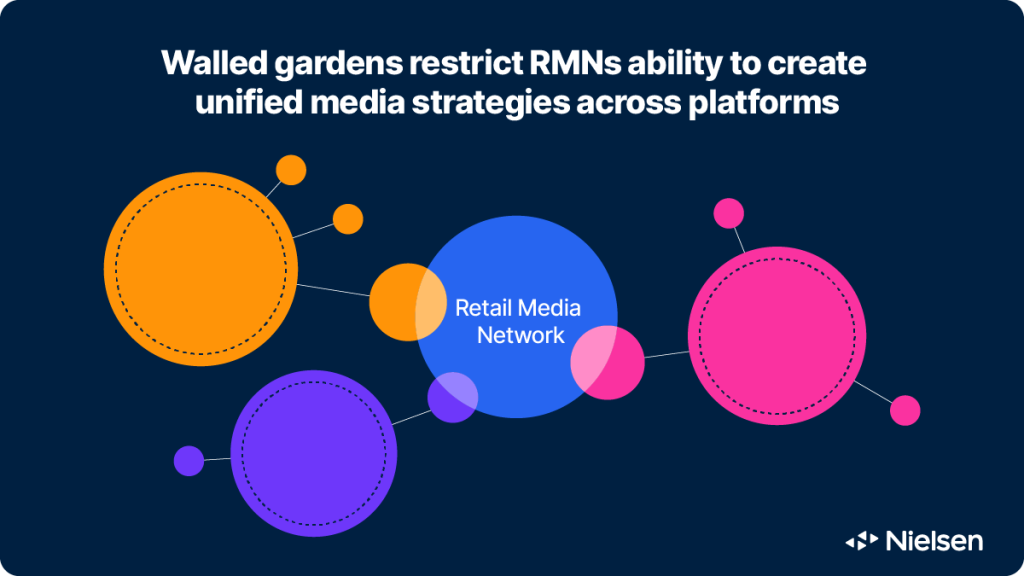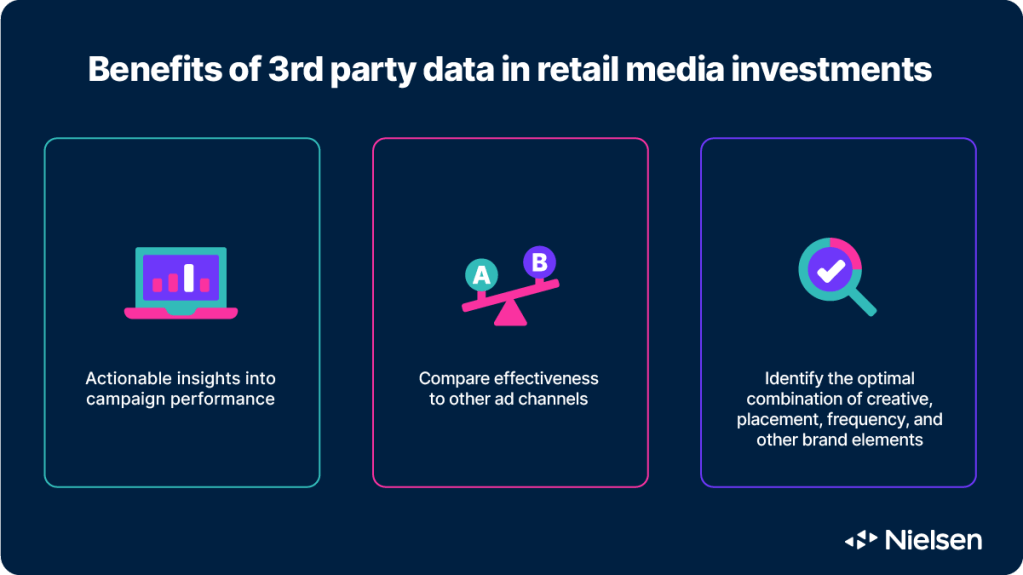Worldwide retail media ad spending is projected to increase by nearly $100 billion between 2020 and 2025. Its 21.8% predicted rise this year will outpace growth rates in nearly all other forms of ad spending. Simply put, advertisers are putting greater emphasis on retail media in their ad plans.
Based on Nielsen’s 2024 Annual Marketing Report, 68% of global marketers say retail media is more important to their media strategies than a year ago. Advertisers are eager to turn to retail media networks (RMNs) to better connect with their consumers using robust first-party data. But while this data presents exciting opportunities for advertisers to better connect with their consumers, much of it is contained within walled gardens.
Walled gardens aren’t new to advertising—any closed platform with proprietary data that limits what information is shared can be called a walled garden. For advertisers, concerns can arise when these types of closed platforms offer both promises of ad performance and measurement of that performance. Potential conflicts of interest can emerge from this dual role, and over time, the isolated view provided by RMNs has proven insufficient. As the marketplace becomes more crowded, advertisers are growing dissatisfied with piecing together performance data from separate RMN silos and are seeking a more comprehensive perspective on their investments across multiple platforms.

Given these challenges, independent third-party measurement has become critical for advertisers to get a clear view of what they’re buying and ensure that they’re getting what they paid for across different RMNs.
The benefits of retail media networks
Over the past few years, RMNs have experienced significant global growth amongst increasingly fierce e-commerce competition. As brands eagerly seek to capture market share, retail media networks have emerged as a powerful tool to reach and engage consumers at the point of purchase.

For retailers, retail media provides a clear benefit—new revenue opportunities in an increasingly competitive e-commerce environment. But the benefits go beyond just dollars. Retail media can help develop brand partnerships, grow retailers’ understanding of the customer and improve customer experience with more relevant advertising.
For advertisers, the lure of the first-party data retailers can offer through their networks is appealing. Transaction-based data collected at the point of sale can help advertisers create and reach highly targeted advanced audience segments.
While the allure of rich first-party data draws in advertisers and brands by providing access to detailed data collected directly from shopping transactions, closed ecosystems and proprietary platforms can create blindspots. Data remains confined within the boundaries of these gated communities.
Given these potential limitations, can you truly trust the data?
The challenge of RMNs
According to Digiday, approximately one-third of companies are now utilizing retail media channels. In the U.S., retail giants such as Amazon, Home Depot, Instacart, Kroger, Target and Walmart now have their own retail media network enabling brands to target shoppers both on their websites and across other digital properties. And around the world, local and regional players, such as Carrefour, FlipKart, Mercado Libre, Lazada, Tesco and Zalando, are also quickly growing their footprints. For advertisers running campaigns across multiple RMNs, reporting of consistent and comparable metrics can be challenging.
These challenges are also compounded by recent changes in digital consumer data collection practices. The gradual phaseout of third-party cookies, long essential for digital advertising and user tracking, is one such change. Another is the implementation of stricter privacy regulations worldwide, such as GDPR in Europe and CCPA in California.
Due to the fragmented nature of these retail media networks and digital privacy developments, advertisers face limitations in developing cohesive, data-driven marketing strategies that span various platforms and touchpoints within this fragmented environment. Platforms, too, have their own set of challenges—these closed ecosystems restrict their ability to verify data, benchmark performance and create unified media strategies across platforms.
The role of third-party measurement
Without independent, third-party measurement of retail media networks, advertisers will struggle to gauge how effective their campaigns are in the context of their larger media plans. Third-party measurement providers can help a brand understand which RMNs are working best for them—and why. Brands can discover not only how retail media investments perform relative to the many other ad channels it utilizes, but also how creative, placement, frequency and other brand choices play into that effectiveness.
Similarly, platforms can benefit from third-party measurement by gaining the ability to offer transparency and competitive insights, enabling them to showcase their inventory value, benchmark against other RMNs and, most importantly, effectively demonstrate their worth to advertisers.
In both cases, third-party data ensures transparency, comparability and comprehensive insights across RMNs. Independent measurement in retail media attribution achieves these crucial objectives through:
- Trustworthy and unbiased information
Neutrality in measurement addresses a major challenge in the retail media ecosystem, where platforms may have an inherent bias toward presenting their performance in the most favorable light. Unlike self-reported metrics from platforms or advertisers’ internal analytics, independent entities have no vested interest in inflating or downplaying results. With independent measurement, advertisers can trust that the data they receive is an accurate representation of their campaigns’ effectiveness, free from potential conflicts of interest or biased interpretations.
- Standardized metrics
Different platforms may use varying definitions for metrics like impressions, clicks, or conversions. Third-party measurement introduces standardized metrics across all channels and platforms. The standardization enables advertisers to make apples-to-apples comparisons both between different RMNs and against other advertising channels.
- Unified measurement framework
An integrated analytics approach provided by third-party entities offers a holistic view of advertising performance across all channels. Such a comprehensive approach allows advertisers to understand the interplay between different media investments. It helps measure the true impact of advertising through incrementality-based outcome KPIs, identify synergies, and provide understanding of the customer journey across multiple touchpoints.
Independent measurement can serve as an arbiter, creating consistency across the media mix. As a provider of such measurement, Nielsen aims to help marketers understand if they are getting what they paid for—unbiased and free from skews caused by self-reporting or varying methodologies.
Nielsen ONE, the industry’s most reliable cross-media planning solution, facilitates a holistic view of advertising performance across mediums. Effective retail media attribution, supported by Nielsen’s measurement, helps advertisers understand the impact of their media campaigns in the context of their broader marketing efforts.
Nielsen’s Need to Know reviews the fundamentals of audience measurement and demystifies the media industry’s hottest topics. Read every article here.



